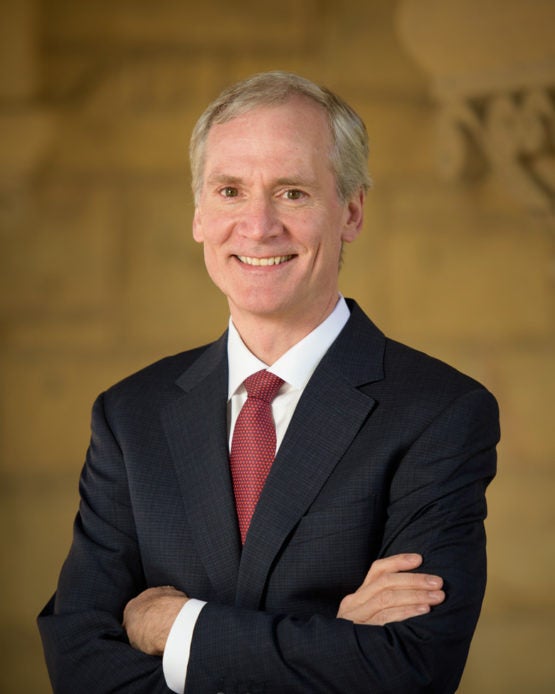Stanford President-elect Marc Tessier-Lavigne is preparing to take office Sept. 1
The incoming leader’s spring agenda included attending Board of Trustees meetings and making preparations to hire a new provost.
President-elect Marc Tessier-Lavigne has been readying for his official start on Sept. 1 with a focused set of activities, while fulfilling his full-time responsibilities at The Rockefeller University.

Marc Tessier-Lavigne (Image credit: L.A. Cicero)
In the months since his February appointment was announced, Tessier-Lavigne attended the April meeting of the Stanford Board of Trustees as an observer. He also had extensive meetings with the president and provost, the deans of all seven Stanford schools, cabinet members, and other administrators and faculty members, and he participated remotely in the Board of Trustees meeting earlier this month.
Tessier-Lavigne extended congratulations and an invitation for fall meetings with newly elected student leaders. And he was consulted on the recent appointment of economics Professor Jonathan Levin as the new dean of the Graduate School of Business, in the process learning in-depth about the school and its needs from search committee members and other stakeholders.
“I am excited by what I’ve seen so far, and I am trying to learn as much as I can before I am able to return to the Bay Area and engage full time with this vibrant intellectual community,” said Tessier-Lavigne, who was a Stanford faculty member in the early 2000s and a 20-year Bay Area resident.
One of Tessier-Lavigne’s first tasks will be to appoint a provost, the chief academic and budgetary officer of the university. A provost advisory committee, chaired by Richard Saller, dean of the School of Humanities and Sciences, has been appointed and issued a call for nominations last month.
The provost search was launched in May to allow time for the advisory committee to complete its work. The advisory group will forward its findings to Tessier-Lavigne, who expects to select a new provost in the fall, with the objective of having the new provost assume the position in early to mid-2017, in time to help initiate long-range planning with the new president. Provost John Etchemendy has agreed to serve until his successor is in office, and then will be available to advise the new university leadership through the summer of 2017. Stanford President John Hennessy will continue to serve as president through August 31, 2016.
To stay informed of campus developments and major issues, Tessier-Lavigne receives regular briefings from the Office of Public Affairs and an administrative transition team. He also is an avid reader of Stanford Report, Stanford magazine, the Stanford Daily and numerous university websites and social media channels. An interview with Stanford magazine will appear in the September issue.
The incoming president’s brief visits to Stanford have been limited, however, by his ongoing obligations as president of The Rockefeller University in New York City. In May, Rockefeller named a successor to Tessier-Lavigne, geneticist Richard P. Lifton of Yale University, also starting Sept. 1.
“I am pleased that Rockefeller will be in great hands. I am committed to assisting with the transition at Rockefeller at the same time as I am eager to more fully immerse myself in the Stanford community,” said Tessier-Lavigne. “I can’t wait to get back to the Farm and get started.”
Tessier-Lavigne, a pioneering neuroscientist, has maintained an active research lab at Rockefeller focusing on brain development and on the causes of degenerative brain diseases such as Alzheimer’s. He will transfer his lab, along with several of his graduate students and postdoctoral fellows, to Stanford.
“This will be a short-term transition to make sure that people who have already invested considerable time with me can complete their studies. They made a commitment to me, and in turn I want to do right by them,” said Tessier-Lavigne, who said he will not take on additional graduate students or postdoctoral fellows and will close the lab when his current trainees complete their studies.
Later this summer, Tessier-Lavigne and his wife, Mary Hynes, will return to Stanford. Hynes, also a neuroscientist at Rockefeller, will transfer her research lab back to Stanford, where she had previously maintained a lab. The couple will live in a temporary home on campus while Hoover House, the Stanford president’s official residence, undergoes some necessary work after 16 years of continual occupancy.
Tessier-Lavigne will also become a Stanford parent when his youngest child, daughter Ella, arrives as an entering freshman of the Class of 2020. An early action applicant, Ella knew she was headed to Stanford before her father was tapped for the presidency.
“I had the privilege of attending Admit Weekend activities as an incoming parent,” Tessier-Lavigne said. “It was wonderful to have the opportunity to view Stanford from that perspective as well.”
Tessier-Lavigne has been president of The Rockefeller University, a premier biomedical research and graduate education institution, since 2011. He was the unanimous choice presented to the Stanford Board of Trustees by a 19-member search committee that spent six months reviewing prospective candidates in a comprehensive, global search.
Tessier-Lavigne was a professor of biological sciences at Stanford from 2001 to 2005 and held the Susan B. Ford Professorship, having been recruited to the post by President John Hennessy.
Tessier-Lavigne was an assistant professor of anatomy at the University of California, San Francisco, in 1991. He rose to associate and then full professor of anatomy and of biochemistry and biophysics at UCSF, where he earned various teaching honors. He was an investigator with the Howard Hughes Medical Institute from 1994 until his transition to Genentech in 2003. At Genentech, Tessier-Lavigne served in roles of increasing managerial responsibility, including as executive vice president for research and chief scientific officer, overseeing 1,400 scientists focusing on disease research and drug discovery. He moved to Rockefeller in 2011.
